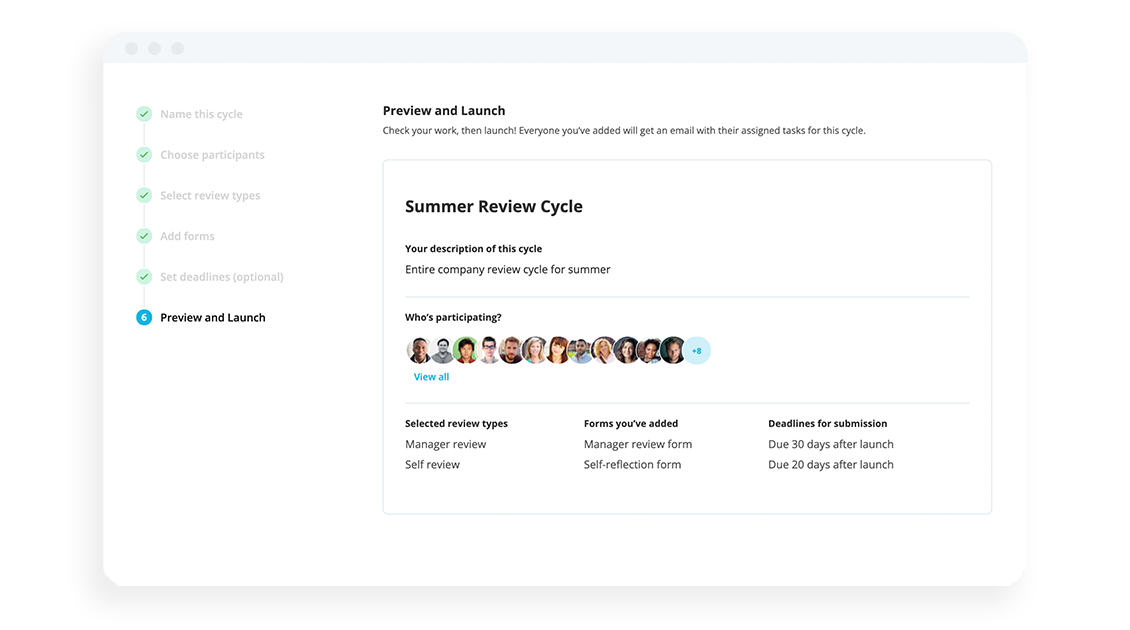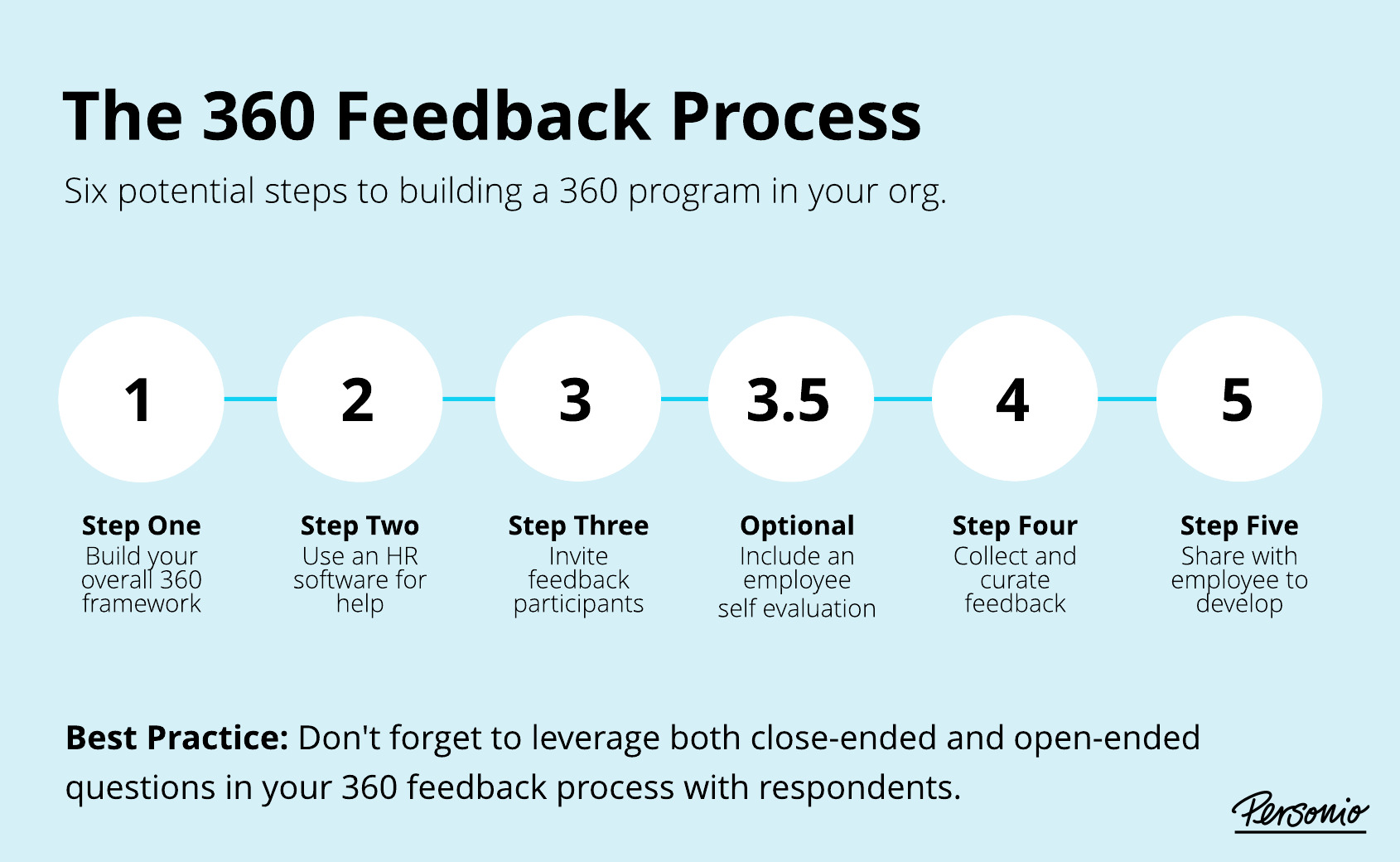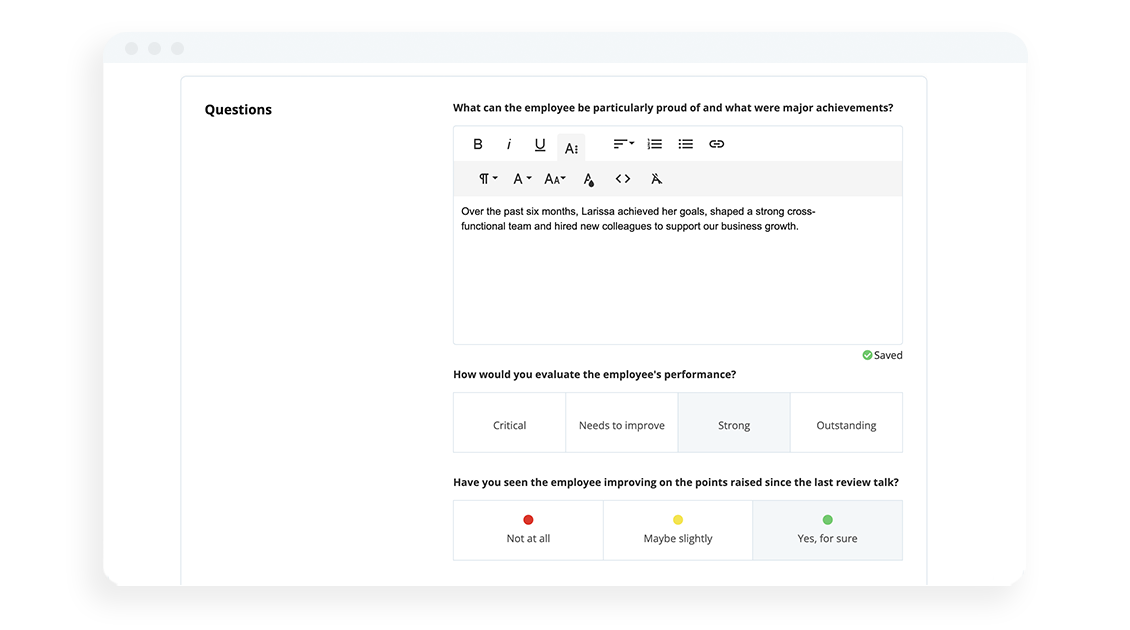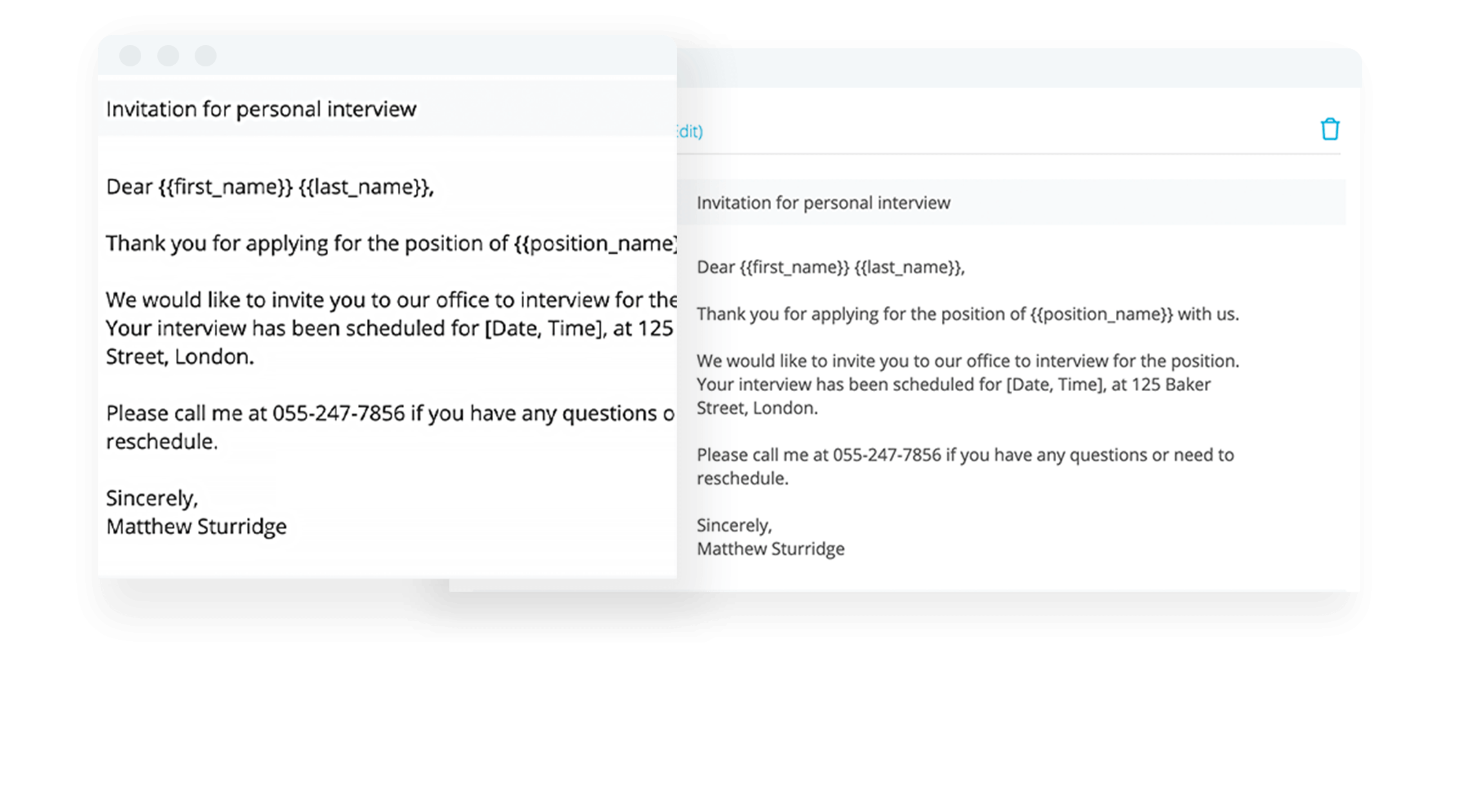360 feedback can be an incredibly important tool for performance management. Why? Because it can result in a more holistic, comprehensive, and effective review system. In this article, we break down what it means, offer a handful of sample questions organizations can ask, and how you can put your 360 feedback plan in action today.
Start from the top with our performance review template today.
Contents
What Is 360 Feedback?
How Does The 360 Feedback Process Work?
Implementing A 360 Feedback Program: Step-By-Step
360 Feedback Questions: Examples & Template
What Are The Components Of A Great 360 Feedback Question?
Template: How Do You Ask Respondents To Leave Feedback?
HR Best Practices: 360 Feedback
What Is 360 Feedback?
360 feedback is the process of relying on an employee’s reports, colleagues, managers, or other senior leaders to assess their performance. Rather than relying on just an employee’s manager, the mission of 360 feedback is to collect a variety of voices and opinions to gain a more nuanced evaluation of an employee’s performance in their role.
Why Is 360 Feedback Important?
360 feedback can be a key strategic tool for organizations when it comes to identifying and developing leaders. Especially in a business that is scaling quickly or in hypergrowth, 360 feedback is a means to an end when it comes to figuring out how employees collaborate, how they lead projects, and how well they get work done with multiple stakeholders.
So, whether as a pillar of growth or succession planning, 360 feedback can serve the purpose of helping identify if an employee is growing in their role and if they are a candidate for leadership down the road.
In addition to that, it’s hard to ignore the kind of trickle-down effect that implementing a 360 feedback program can have on your type of company culture. Implementing a large-scale feedback process, one that loops in the entire company, may drive a culture of feedback (for better or worse, depending on how well your employees are prepared to take feedback).
What Are The Drawbacks Of 360 Feedback?
Some of the key drawbacks of 360 feedback include:
- Effort – It takes a lot of work to get a 360 feedback program off the ground, especially in larger organizations. For that reason, it can be quite time-consuming — which is why having an HR software to cover all your other tasks and reminders definitely helps.
- Anonymity – Keeping employees anonymous can be a bit of a double-edged sword. It can help employees express their opinions freely, but it can also lead to them being more empowered to be hyperbolic or make grand, sweeping statements that don’t help employees deliver.
While these drawbacks do exist, it’s not like there’s nothing we can do about them. First, HR teams can save time elsewhere by introducing an HR software that helps cover their routine tasks. Additionally, the framing of 360 feedback questions can definitely help address the anonymity question. More on that later, but first…
What Are The Benefits Of 360 Feedback?
There’s a lot of work involved in getting a 360 feedback program off the ground, so is it worth it? If you’re looking to divorce yourself from the typical manager-employee feedback process, but not sure if it’s worth the time involved, here are some of the benefits of launching 360 feedback within your organization:
- Objectivity – When you extend feedback to multiple stakeholders, and not just one, you’ll more get more unbiased, objective, and therefore usable feedback.
- Accuracy – If you loop in varying stakeholders, especially those who have worked intimately on a project or on a day-to-day basis with an employee, you’ll gain a more accurate picture of their success.
- Engagement – Employees want to feel included, and that definitely extends to leaving feedback. Whether to praise or to help an employee learn, 360 feedback can have an effect on how you measure employee engagement.
- Development – When an employee knows they are getting feedback from multiple sources, and don’t see the process as biased, they are more likely to take the learnings of the feedback process and implement them in their working life.
Should 360 Feedback Be Anonymous?
In almost every case, yes. If you want more honest responses from stakeholders, then you should make 360 feedback anonymous. That said, you can leave room for respondents to choose to leave a named response (if they feel it would be instructive to the person receiving the feedback). That said, this should remain only an option.
Boost Retention With Seamless Performance Management
Use your review cycles to reward your highest performers and to give all your employees the opportunity to improve how they work. Track everything from one powerful dashboard.
How Does The 360 Feedback Process Work?
The process of implementing a 360 feedback process typically starts by confirming eligibility criteria. Will you offer 360 feedback questions to all employees or only senior ones? 360 feedback is appropriate for just about any level of an organization, but the trick may be operationalizing it — you may want to start with a smaller pool of candidates at first.
The next is to come up with some 360 feedback questions. These are typically a combination of open-ended and closed-ended questions that would be asked of anyone surrounding one particular employee. The mix here is crucial, as you want to make the questions easy to answer (to avoid delays) but substantive to accurately rate performance.
We’ll cover more 360 feedback questions later on in this article (with some handy example questions, too). The last step, though, and potentially the most crucial, is collecting that feedback in a way that is digestible, unbiased, and reviewable with an employee. Ultimately, your HR team needs to structure it in a way that it makes sense for an employee.
Implementing A 360 Feedback Program: Step-By-Step
If you’re sold on 360 at this point and want to get started, let’s kick things off with the full breakdown of how you should go about building your program:
Step 1: Build your 360 feedback framework — define eligibility criteria, the rollout process, the necessary documentation, and how you will make the entire company aware of the change.
Step 2: Working alongside an HR software that affords the opportunity to automate performance cycles, build a feedback module that suits the 360 feedback process.
Step 3: During an employee’s performance cycle, invite colleagues, managers, senior leaders, and other stakeholders to answer questions regarding that employee’s performance (more on those questions later).
Step 3.5: This is an optional step, but one that many organizations (Personio included) promote. Have your employee complete their own self-evaluation, and treat them as key stakeholders in the overall 360 feedback process.
Step 4: Collect all of the feedback, share it with the employee’s manager, and find a way to package it in a way that will make sense for the employee. Offer a tailored, summarized version that leaves out specifics that single out respondents.
Step 5: Share with the employee the feedback and work with them to define action steps that can help them develop in their role. In addition, be sure to thank those who weighed in.
The Importance Of 360 Feedback At Personio
We mentioned that Personio offers a 360 feedback process to all of our employees, but how does it work? Read this article to find out more about what 360 feedback looks like at Personio.
360 Feedback Questions: Examples & Template
Earlier, we covered the two key types of 360 feedback questions: closed-ended and open-ended. But, how do these questions look in practice, and what questions get the most meaningful results?
First, let’s talk about the merits of each type of question:
| Close-Ended | Open-Ended |
|---|---|
| Questions like these are typically plotted on a Likert Scale, from one to five, and are therefore more quantifiable in their results (you can average them out for a nice number). For that reason, they need to be questions that respondents can answer confidently in terms of agreement (from 'strongly disagree' to 'strongly agree'). | An open-ended question is where you'll get all of the details regarding an employee's performance, and is a great opportunity to learn more about how they work and how they make respondents feel. That said, they require much more effort and are therefore better served 'short and sweet' for the best possible answers. |
360 Feedback Questions: Closed-Ended
Here are some examples of popular closed-ended questions you can ask:
- This employee meets their deadlines and works in an efficient manner
- This employee brings a good attitude into their work and works with others.
- This employee is clear in how they communicate with other team members.
- This employee offers creative problem-solving in the face of potential issues.
- This employee embodies your company culture or values.
- This employee is often focused on the task at hand and completing projects.
- This employee is transparent in their approach and communicates decisions.
- This employee completes their work to a high standard with great diligence.
- This employee would be described as a role model in your organization.
- This employee always keeps the needs of the customer/target audience top of mind.
360 Feedback Questions: Open-Ended
Here are some examples of popular open-ended questions you can ask:
- What kind of role has this employee taken when working on projects together?
- What is one thing this employee should start doing in their role?
- What should this employee continue doing in their role that works well?
- What should this employee stop doing that isn’t working for them?
- How has this employee lived your company’s culture or values?
- How does this employee handle taking feedback and putting it into practice?
- Does this employee approach their work with diligence and attention to detail?
- How has your communication been with this employee on projects?
- Where do you think this employee could improve in your working relationship?
- How could you see this employee taking the next step in their development?
Coming Soon: Gain Vital Insights With 360º Feedback
Enable your managers to get feedback about and from their direct reports. Create multi-level visibility that improves how your people work, company-wide.
What Are The Components Of A Great 360 Feedback Question?
Want to deviate from our suggestions and give it a try yourself? Here are some of the things you should keep in mind whenever you’re formulating your own 360 feedback questions:
| Component | Defined |
|---|---|
| Framing | Offer a world of opportunity for responses and avoid leading the respondent into a particular response. You want to make sure that your question is incredibly open-ended and can be answered in multiple ways. |
| Measuring | Don't ask the world of your respondents. Each question you ask should key in a core skill: leadership, operational work, collaboration. Have them evaluate one skill at a time. |
| Exampling | Ask questions that can naturally lead to examples. That way, the feedback can become more actionable in terms of what an employee should do or stop doing. |
| Wording | Avoid messy jargon or buzzwords. Don't ask respondents if the employee in question has that "it factor" or anything intangible. What you want is concrete feedback, not shallow praise or criticism. |
Template: How Do You Ask Respondents To Leave Feedback?
As part of the performance process, you should make sure to loop in employees part of the 360 feedback process as early as possible. This way, they have the chance to collect their thoughts and provide the best answers.
When you have an HR software that is up to the task, you can even send templated emails that go out automatically to employees to invite them to leave their feedback.
Here is an example template of how that might look — please keep in mind, though, that the message should suit your culture and should excite the respondent to want to fill out the feedback form:
SUBJECT LINE: You’ve Been Selected To Leave Feedback!
Hello [Employee Name],
Great news, you’ve been selected to leave feedback for your fellow colleague [Evaluatee Name]!
If you click the following link, you will find the form where you can fill out all the relevant questions. Make sure to leave honest, transparent feedback, and leave examples of your work together whenever possible.
We want to thank you for your time and for being such an important part of this process.
Thanks again,
[Company Name]
Save Time With Automated Emails
Automatically generate welcome emails, invite candidates to interviews, send employment contracts, and invite employees to leave feedback with powerful templates.
HR Best Practices: 360 Feedback
There are two best practices that are absolutely essential to the success of any 360 feedback program: coaching your respondents and promoting transparency across your org.
The first should be a bit obvious. Not only do you want people to respond in a timely fashion, but you want them to leave the best possible answers while also enjoying the process.
So, your organization should not only share what your new process looks like but should hold informal sessions as to how to leave amazing feedback that is actionable for employees. Feedback is an art form, so you need to coach potential respondents to succeed in the process.
This feeds into the second point: transparency. The last thing you want is for the introduction of your new feedback program to seem like a disciplinary measure or something to be feared. This is where your HR team comes into the mix.
Share with your entire organization, ideally, during an all-team meeting where everyone is present, the purpose of the 360 feedback process, how you have built it, and which considerations you made along the way.
When you do this, employees will come to understand why the program exists, and they will leave feedback that speaks to those core principles. In short, everybody wins because everyone is on the same page!
Boost Performance
With Personio









